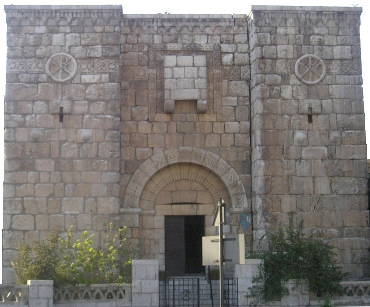Damascus was eventually conquered by Alexander the Great in 331 B.C. After the death of Alexander, the city became the site of the struggle between the Seleucid and Ptolemaic empires.
In 64 B.C. Pompey, a Roman general, annexes the western part of Syria which included Damascus. The Romans soon occupy the city and incorporated it into a ten-city league referred to, in the New Testament, as the Decapolis (Mark 4:25, 5:20, 7:31).
A Life Changing Event
Before his conversion, the Apostle Paul actively persecuted those who believed Jesus was the Messiah. After the martyrdom of Stephen (Acts 6 - 7), Paul obtains direct permission from the High Priest to search for believers in Damascus' synagogues. Paul is also given authority to arrest any believers found in the synagogues and bring them bound back to Jerusalem so that they can be tried and punished (Acts 9:1 - 2).

On his way to Damascus Paul sees a bright light from heaven surround him, hears the voice of Jesus who calls him to repent, and is blinded. He is taken into the city by his companions. After three days without sight, Paul is healed by a man name Ananias, a believer in God, who is inspired by Jesus to visit him. After his repentance and healing Paul (Saul) is put under the waters of baptism and receives the Holy Spirit.
. . . . as (Saul, soon after renamed Paul) drew near to Damascus, that suddenly a light from heaven shined round about him. And after falling to the ground, he heard a voice say to him, "Saul, Saul, why do you persecute Me?" . . . (Acts 9:3 - 4).
God reveals to Ananias that Paul, who brought persecution and suffering to countless believers, will himself suffer greatly for his faith and for his efforts to serve the true God (Acts 9:3 - 6, 16 - 18).
Preaching in Damascus
Paul immediately starts to preach the gospel in Damascus. His incredible ability to prove Jesus is the Christ (Messiah) so angers Jews within the city that they plot to murder him in cold blood (Acts 9:20 - 23). Paul soon learns of the death threat against him.
Christians already in Damascus who fear for Paul's life help him escape the city, at night, by putting him in a basket and lowering him down the outside part of a city gate. The Bab Kisan (The Kisan Gate) pictured above, built during the Roman era, is believed to be the gate used to help Paul flee the city. The apostle, after leaving the city and the threats against his life, goes to Arabia. He spends three years in Arabia where he is taught, directly, by Jesus Christ (Galatians 1:11 - 12, 15 - 18).